We took the long road to Rundu for the Easter Weekend. Rundu is at the northern border of Namibia and lies on the river which borders Angola. Because of the heavy rains this year in the north the Kavango river is very much flooded. This made the view over the river very beautiful.
There is not much to see across the river in Angola. Actually, we were told that there was not even a road that started at that point in the country. The only way across via Rundu was via an informal ferry. I highly doubt that passports will be checked! We may have tried it, but because of the flooding we could not even access the ferry docks. By the way, the ferry is just a canoe!
Great sunsets over the Kavango river and Angola on the right.
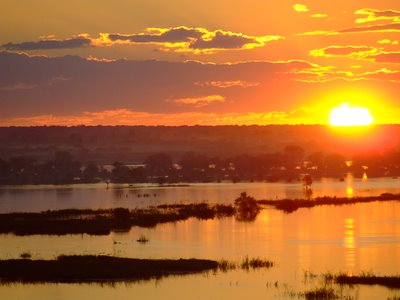
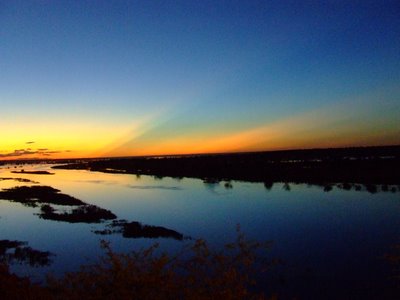
Informal ferry making passage to Angola. Joking, actually a ‘commercial’ fisherman gathering from his fishing nets early in the morning.
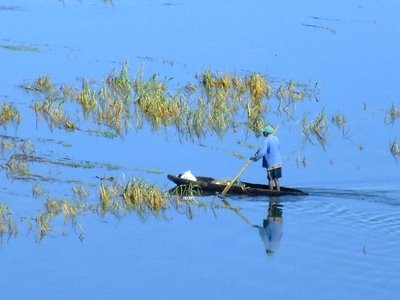
Something new in the horticulture world. These trees sprouted salami!! They were heavy and had the density of a tree trunk. Very different!
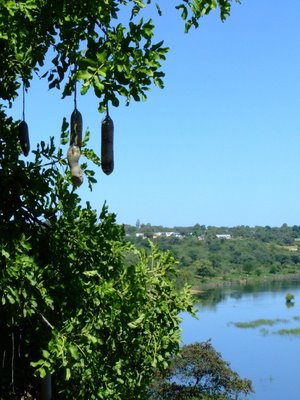
As part of our visit to Rundu we paid a visit to a Russian doctor who specializes in prosthetics. There are many amputees in the area because of the high frequency of land mines found on the Caprivi strip and in southern Angola. These mines are remnants of the wars fought here not too long ago.
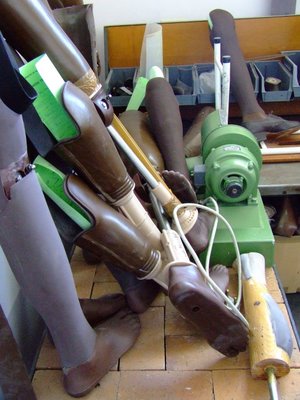
Rundu hospital

Some of the older AIDS awareness advertisements are extremely tacky.

At the Rundu open air market we see fish done in a tradiational Angolan/Portuguese style .
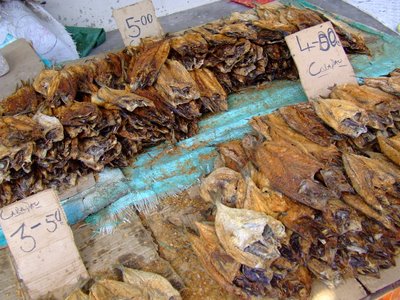
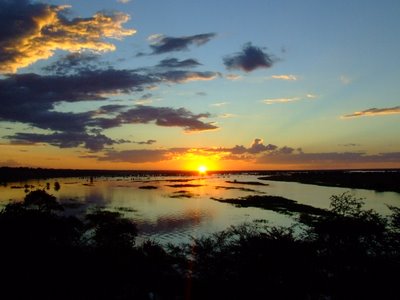
Gigantic millipede! Well it was…
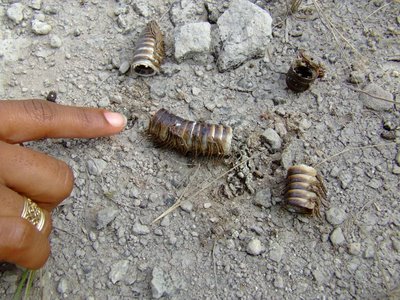
Kimera hanging out at the banks of the Kavango river. We did not see any crocodiles.

Hopefully this lone fisherman did not meet any crocodiles either. We were told at the lodge that all of the crocodiles were on the Angolan side of the river…..yeaaaaaaa…sure!!!!
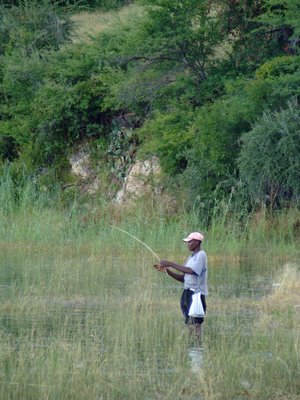

On the way back to Windhoek we stopped at the Hoba Meteorite, the largest intact meteorite on the face of the planet!
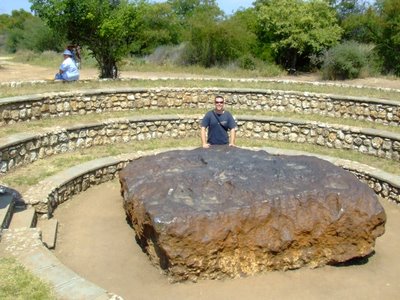
Info on the meteorite:
The Hoba meteorite, also known as the Hoba West meteorite, is the heaviest meteorite in the world and the largest naturally-occurring mass of iron known to exist on the surface of the earth. The meteorite, named after the Hoba West Farm near Grootfontein, Namibia, where it was discovered in 1920, has not been moved since it landed over 80,000 years ago. The discovery of the Hoba meteorite was a chance find, as it left no crater or other sign of impact; evidently the Earth’s atmosphere slowed down the 66-ton iron body enough so that it fell at terminal velocity. At this speed, the meteorite stayed basically intact and the low-energy impact with the surface caused little excavation. The meteorite is unusual in that it is flat on both major surfaces, possibly causing it to have skipped across the top of the atmosphere in the way a flat stone skips on water.
The Hoba meteorite is a tabloid body of metal, measuring 2.7 by 2.7 metres (8 feet 9 inches) by 0.9 meters (3 feet). Its mass in 1920 was estimated at 66 tonnes. Erosion, scientific sampling and vandalism took their toll and over the years the meteorite shrank to just over 60 tonnes. This led the Government of Namibia (then South West Africa) to declare the Hoba meteorite a National Monument in March 1955, in order to forestall further vandalism.
The meteorite is composed of 84% iron and around 16% nickel with some traces of cobalt. There are crusts of iron hydroxides on the surface in parts. In scientific terms, the meteorite is classed as a nickel-rich ataxite.
The Hoba meteorite was discovered by the owner of the Hoba West farm and was identified and described soon after by the scientist J. Brits. His original report (1920) can be seen at the Grootfontein Museum in Namibia. The owner of the land is said to have encountered the giant meteorite while ploughing one of his fields with an ox. During this task, the farmer heard a loud, metallic, scratching sound before his plough came to a dead stop. The farmer uncovered the meteorite soon after.
In 1985, Rossing Uranium Ltd. made resources and funds available to the Namibian Government so that additional protection against vandalism could be provided. The owner of the farm Hoba West donated the meteorite and the site where it lies to the State for “educational” purposes in 1987. Later that year, the Government opened a tourist centre at the site. As a result of these developments, vandalism of the Hoba meteorite has ceased. It is visited by thousands of tourists every year. Source
Like this:
Like Loading...
Michael Paskevicius
Share post:
We took the long road to Rundu for the Easter Weekend. Rundu is at the northern border of Namibia and lies on the river which borders Angola. Because of the heavy rains this year in the north the Kavango river is very much flooded. This made the view over the river very beautiful.
There is not much to see across the river in Angola. Actually, we were told that there was not even a road that started at that point in the country. The only way across via Rundu was via an informal ferry. I highly doubt that passports will be checked! We may have tried it, but because of the flooding we could not even access the ferry docks. By the way, the ferry is just a canoe!
Great sunsets over the Kavango river and Angola on the right.














Informal ferry making passage to Angola. Joking, actually a ‘commercial’ fisherman gathering from his fishing nets early in the morning.
Something new in the horticulture world. These trees sprouted salami!! They were heavy and had the density of a tree trunk. Very different!
As part of our visit to Rundu we paid a visit to a Russian doctor who specializes in prosthetics. There are many amputees in the area because of the high frequency of land mines found on the Caprivi strip and in southern Angola. These mines are remnants of the wars fought here not too long ago.
Rundu hospital
Some of the older AIDS awareness advertisements are extremely tacky.
At the Rundu open air market we see fish done in a tradiational Angolan/Portuguese style .
Gigantic millipede! Well it was…
Kimera hanging out at the banks of the Kavango river. We did not see any crocodiles.
Hopefully this lone fisherman did not meet any crocodiles either. We were told at the lodge that all of the crocodiles were on the Angolan side of the river…..yeaaaaaaa…sure!!!!
On the way back to Windhoek we stopped at the Hoba Meteorite, the largest intact meteorite on the face of the planet!
Info on the meteorite:
The Hoba meteorite, also known as the Hoba West meteorite, is the heaviest meteorite in the world and the largest naturally-occurring mass of iron known to exist on the surface of the earth. The meteorite, named after the Hoba West Farm near Grootfontein, Namibia, where it was discovered in 1920, has not been moved since it landed over 80,000 years ago. The discovery of the Hoba meteorite was a chance find, as it left no crater or other sign of impact; evidently the Earth’s atmosphere slowed down the 66-ton iron body enough so that it fell at terminal velocity. At this speed, the meteorite stayed basically intact and the low-energy impact with the surface caused little excavation. The meteorite is unusual in that it is flat on both major surfaces, possibly causing it to have skipped across the top of the atmosphere in the way a flat stone skips on water.
The Hoba meteorite is a tabloid body of metal, measuring 2.7 by 2.7 metres (8 feet 9 inches) by 0.9 meters (3 feet). Its mass in 1920 was estimated at 66 tonnes. Erosion, scientific sampling and vandalism took their toll and over the years the meteorite shrank to just over 60 tonnes. This led the Government of Namibia (then South West Africa) to declare the Hoba meteorite a National Monument in March 1955, in order to forestall further vandalism.
The meteorite is composed of 84% iron and around 16% nickel with some traces of cobalt. There are crusts of iron hydroxides on the surface in parts. In scientific terms, the meteorite is classed as a nickel-rich ataxite.
The Hoba meteorite was discovered by the owner of the Hoba West farm and was identified and described soon after by the scientist J. Brits. His original report (1920) can be seen at the Grootfontein Museum in Namibia. The owner of the land is said to have encountered the giant meteorite while ploughing one of his fields with an ox. During this task, the farmer heard a loud, metallic, scratching sound before his plough came to a dead stop. The farmer uncovered the meteorite soon after.
In 1985, Rossing Uranium Ltd. made resources and funds available to the Namibian Government so that additional protection against vandalism could be provided. The owner of the farm Hoba West donated the meteorite and the site where it lies to the State for “educational” purposes in 1987. Later that year, the Government opened a tourist centre at the site. As a result of these developments, vandalism of the Hoba meteorite has ceased. It is visited by thousands of tourists every year. Source
Share this:
Like this: